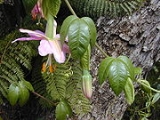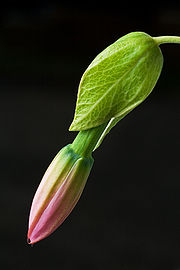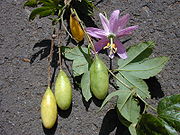
Passiflora tarminiana
Encyclopedia

Species
In biology, a species is one of the basic units of biological classification and a taxonomic rank. A species is often defined as a group of organisms capable of interbreeding and producing fertile offspring. While in many cases this definition is adequate, more precise or differing measures are...
of passionfruit. The yellow fruits are edible and their resemblance to small, straight bananas has given it the name banana passionfruit
Banana passionfruit
Banana passionfruit is the fruit of several plants in the genus Passiflora, and are therefore related to the passion fruit. They look somewhat like a straight, small banana with rounded ends. It was given this name in New Zealand, where passionfruit are also prevalent. In Hawaii, it is called...
in some countries. It is native to the uplands of tropical South America
South America
South America is a continent situated in the Western Hemisphere, mostly in the Southern Hemisphere, with a relatively small portion in the Northern Hemisphere. The continent is also considered a subcontinent of the Americas. It is bordered on the west by the Pacific Ocean and on the north and east...
and is now cultivated in many countries. In Hawai'i
Hawaii
Hawaii is the newest of the 50 U.S. states , and is the only U.S. state made up entirely of islands. It is the northernmost island group in Polynesia, occupying most of an archipelago in the central Pacific Ocean, southwest of the continental United States, southeast of Japan, and northeast of...
and New Zealand
New Zealand
New Zealand is an island country in the south-western Pacific Ocean comprising two main landmasses and numerous smaller islands. The country is situated some east of Australia across the Tasman Sea, and roughly south of the Pacific island nations of New Caledonia, Fiji, and Tonga...
it is now considered an invasive species
Invasive species
"Invasive species", or invasive exotics, is a nomenclature term and categorization phrase used for flora and fauna, and for specific restoration-preservation processes in native habitats, with several definitions....
.
P. tarminina belongs to the Tacsonia subgenus
Subgenus
In biology, a subgenus is a taxonomic rank directly below genus.In zoology, a subgeneric name can be used independently or included in a species name, in parentheses, placed between the generic name and the specific epithet: e.g. the Tiger Cowry of the Indo-Pacific, Cypraea tigris Linnaeus, which...
of Passiflora. It has been known under a number of different names and was only formally described in 2001.
Description
Passiflora tarminina is a high climbing vineVine
A vine in the narrowest sense is the grapevine , but more generally it can refer to any plant with a growth habit of trailing or scandent, that is to say climbing, stems or runners...
with hairy stems and petioles
Petiole (botany)
In botany, the petiole is the stalk attaching the leaf blade to the stem. The petiole usually has the same internal structure as the stem. Outgrowths appearing on each side of the petiole are called stipules. Leaves lacking a petiole are called sessile, or clasping when they partly surround the...
. Where the petioles join the stem it has stipule
Stipule
In botany, stipule is a term coined by Linnaeus which refers to outgrowths borne on either side of the base of a leafstalk...
s which are 4-7 by 2–3 mm and are soon deciduous
Deciduous
Deciduous means "falling off at maturity" or "tending to fall off", and is typically used in reference to trees or shrubs that lose their leaves seasonally, and to the shedding of other plant structures such as petals after flowering or fruit when ripe...
. The leaves are three-lobed and hairy below but usually hairless above. The flowers are solitary and hang downwards. The base of the flower has pale green bract
Bract
In botany, a bract is a modified or specialized leaf, especially one associated with a reproductive structure such as a flower, inflorescence axis, or cone scale. Bracts are often different from foliage leaves. They may be smaller, larger, or of a different color, shape, or texture...
s enclosing a swollen nectary chamber. The floral tube (hypanthium
Hypanthium
A hypanthium is a floral structure consisting of the bases of the sepals, petals, and stamens fused together. Its presence is diagnostic of many families, including the Rosaceae, Grossulariaceae, and Fabaceae...
) is 6-8 × 0.7–1 cm and pale green, while the sepal
Sepal
A sepal is a part of the flower of angiosperms . Collectively the sepals form the calyx, which is the outermost whorl of parts that form a flower. Usually green, sepals have the typical function of protecting the petals when the flower is in bud...
s and petal
Petal
Petals are modified leaves that surround the reproductive parts of flowers. They often are brightly colored or unusually shaped to attract pollinators. Together, all of the petals of a flower are called a corolla. Petals are usually accompanied by another set of special leaves called sepals lying...
s are 3–6 cm long, pink and perpendicular to the floral tube, or reflexed. Fruits taper at both ends, are 10–14 cm long by 3.5-4.5 cm wide and ripen to yellow or light orange. The fruit contain many seeds which are embedded in an edible, orange aril
Aril
An aril is any specialized outgrowth from the funiculus that covers or is attached to the seed. It is sometimes applied to any appendage or thickening of the seed coat in flowering plants, such as the edible parts of the mangosteen and pomegranate fruit, the mace of the nutmeg seed, or the...
.
P. tarminina is distinguished from P. tripartita var. mollissima by a number of features. P. tarminina has small deciduous stipules while P. tripartita var. mollissima has larger, persistent stipules. The sepals and petals in P. tarminina are perpendicular to the floral tube or are reflexed, whereas they are never so open in P. tripartita var. mollissima. They are also both much shorter in relation to the length of the floral tube in P. tripartita var. mollissima than in P. tarminina.
Taxonomy
The correct taxonomic placement of this species has been problematic for some years. In South America it has been considered under P. cumbalensis, P. mollissima or P. tripartita (the species which now includes P. mollissima), or as a hybrid. In Hawai'i it was referred to as P. mollissima. In New Zealand it was included under P. mixta although some sources also used the name P. mollissima for this species. It was described as a separate species distinct from any of these in 2001. The specific name recognises the Colombian agronomist Tarmín Campos.Common names for P. tarminiana include banana passionfruit (Australia, New Zealand, Africa, Hawai'i), curuba India, curuba ecuatoriana, curuba quiteña (Colombia), tacso amarillo (Ecuador), tumbo (Perú), banana pōka (Hawai'i) (in the Hawai'ian language the word pōka'a refers to tendrils - "that which is tied up in a ball like rope or twine"), northern banana passionfruit (New Zealand).
Distribution
P. tarminiana is native to the uplands of tropical South America but the exact native range is uncertain as it has been widely cultivated in this region. It is found in the Colombian highlands and the Venezuelan, Peruvian and southern Ecuadorean AndesAndes
The Andes is the world's longest continental mountain range. It is a continual range of highlands along the western coast of South America. This range is about long, about to wide , and of an average height of about .Along its length, the Andes is split into several ranges, which are separated...
where it is cultivated from around 2000 – 3000 metres.
It has naturalised in Australia
Australia
Australia , officially the Commonwealth of Australia, is a country in the Southern Hemisphere comprising the mainland of the Australian continent, the island of Tasmania, and numerous smaller islands in the Indian and Pacific Oceans. It is the world's sixth-largest country by total area...
, Guam
Guam
Guam is an organized, unincorporated territory of the United States located in the western Pacific Ocean. It is one of five U.S. territories with an established civilian government. Guam is listed as one of 16 Non-Self-Governing Territories by the Special Committee on Decolonization of the United...
, Hawai'i, New Zealand and Zimbabwe
Zimbabwe
Zimbabwe is a landlocked country located in the southern part of the African continent, between the Zambezi and Limpopo rivers. It is bordered by South Africa to the south, Botswana to the southwest, Zambia and a tip of Namibia to the northwest and Mozambique to the east. Zimbabwe has three...
. In both Hawai'i and New Zealand it is regarded as an invasive species
Invasive species
"Invasive species", or invasive exotics, is a nomenclature term and categorization phrase used for flora and fauna, and for specific restoration-preservation processes in native habitats, with several definitions....
.
It is widely cultivated throughout the world, including California
California
California is a state located on the West Coast of the United States. It is by far the most populous U.S. state, and the third-largest by land area...
, Réunion
Réunion
Réunion is a French island with a population of about 800,000 located in the Indian Ocean, east of Madagascar, about south west of Mauritius, the nearest island.Administratively, Réunion is one of the overseas departments of France...
, Mexico
Mexico
The United Mexican States , commonly known as Mexico , is a federal constitutional republic in North America. It is bordered on the north by the United States; on the south and west by the Pacific Ocean; on the southeast by Guatemala, Belize, and the Caribbean Sea; and on the east by the Gulf of...
, Panama
Panama
Panama , officially the Republic of Panama , is the southernmost country of Central America. Situated on the isthmus connecting North and South America, it is bordered by Costa Rica to the northwest, Colombia to the southeast, the Caribbean Sea to the north and the Pacific Ocean to the south. The...
and Papua New Guinea
Papua New Guinea
Papua New Guinea , officially the Independent State of Papua New Guinea, is a country in Oceania, occupying the eastern half of the island of New Guinea and numerous offshore islands...
.
Biology
In the original description Passiflora tarminina is described as a cultigenCultigen
A cultigen is a plant that has been deliberately altered or selected by humans; it is the result of artificial selection. These "man-made" or anthropogenic plants are, for the most part, plants of commerce that are used in horticulture, agriculture and forestry...
and there is little information about its biology in the wild. Many members of the subgenus Tacsonia are restricted endemics and it is unclear whether the widely cultivated species (such as P. tarminiana) are also local endemics which have been spread through widespread cultivation or whether they are natually widespread species. The type specimen is from a cultivated rather than a wild plant.
Unlike many Passiflora species, P. tarminiana is self-compatible
Self-incompatibility in plants
Self-incompatibility is a general name for several genetic mechanisms in angiosperms, which prevent self-fertilization and thus encourage outcrossing...
, although self-pollination is not considered important in the wild. The main pollinators in South America are believed to be hummingbird
Hummingbird
Hummingbirds are birds that comprise the family Trochilidae. They are among the smallest of birds, most species measuring in the 7.5–13 cm range. Indeed, the smallest extant bird species is a hummingbird, the 5-cm Bee Hummingbird. They can hover in mid-air by rapidly flapping their wings...
s or large bee
Bee
Bees are flying insects closely related to wasps and ants, and are known for their role in pollination and for producing honey and beeswax. Bees are a monophyletic lineage within the superfamily Apoidea, presently classified by the unranked taxon name Anthophila...
s, while in Hawai'i birds were commonly observed robbing nectar but not transferring pollen. Bees and other insects were observed collecting pollen in Hawai'i.
In Hawai'i the seeds are dispersed by frugivorous animals. By far the most important disperser in Hawai'i is the feral
Feral
A feral organism is one that has changed from being domesticated to being wild or untamed. In the case of plants it is a movement from cultivated to uncultivated or controlled to volunteer. The introduction of feral animals or plants to their non-native regions, like any introduced species, may...
pig
Pig
A pig is any of the animals in the genus Sus, within the Suidae family of even-toed ungulates. Pigs include the domestic pig, its ancestor the wild boar, and several other wild relatives...
, which eats the fallen fruit and passes the seeds intact. Feral pigs seek out the fruit and when P. tarminiana occurs with feral pigs in Hawai'i, the seeds are abundant in pig droppings. Germination is not enhanced by gut passage but pigs disturb the ground making a more favourable environment for germination of P. tarminiana. Because their home range is typically one to two square miles, pigs contribute more to the peripheral expansion of P. tarminiana patches than long distance dispersal.
P. tarminiana invades both open and closed forest in Hawai'i. It grows most rapidly in full sun but tolerates some shade. Growth is severely restricted at relative light intensities of less than 2%. Where the forest canopy is largely intact, P. tarminiana invades in canopy gaps formed when trees fall or die.
P. tarminiana hybridises with other members of the subgenus Tacsonia.
Uses

The pink flowers are showy and it is also considered to be an ornamental species.
Control
Three biological controlBiological pest control
Biological control of pests in agriculture is a method of controlling pests that relies on predation, parasitism, herbivory, or other natural mechanisms...
agents have been released in Hawai'i for the control of Passiflora tarminiana. Septoria
Septoria
Septoria are Ascomycete fungi that causes numerous leaf spot diseases on field crops, forages and many vegetables, and is responsible for yield losses...
passiflorae, a fungus
Fungus
A fungus is a member of a large group of eukaryotic organisms that includes microorganisms such as yeasts and molds , as well as the more familiar mushrooms. These organisms are classified as a kingdom, Fungi, which is separate from plants, animals, and bacteria...
, was released in 1996. There have been major epidemics that have substantially reduced the biomass of P. tarminiana. This fungus requires wind and rain to spread and in some areas requires repeated inoculations to achieve control. Two moth
Moth
A moth is an insect closely related to the butterfly, both being of the order Lepidoptera. Moths form the majority of this order; there are thought to be 150,000 to 250,000 different species of moth , with thousands of species yet to be described...
species were also introduced, Cyanotricha necryia, which failed to establish, and Pyrausta perelegans, which suffered substantial levels of egg parasitism and has not become common.
Physical and chemical control methods have generally proved to be ineffective and uneconomic in Hawai'i, although glyphosate has been successfully used to control P. tarminiana in Acacia koa forest.
P. tarminiana is controlled by land management agencies in some areas of New Zealand. Control is either by physical control (for example hand pulling of seedlings) or using herbicide
Herbicide
Herbicides, also commonly known as weedkillers, are pesticides used to kill unwanted plants. Selective herbicides kill specific targets while leaving the desired crop relatively unharmed. Some of these act by interfering with the growth of the weed and are often synthetic "imitations" of plant...
s. Biological control research is underway in New Zealand. The Septoria species from Hawai'i was tested in containment in New Zealand and found to damage Passiflora edulis
Passiflora edulis
Passiflora edulis is a vine species of passion flower that is native to Paraguay, Brazil and northern Argentina . Its common names include passion fruit and passionfruit...
which is grown commercially. Pyrausta perelegans is undergoing host range testing.

